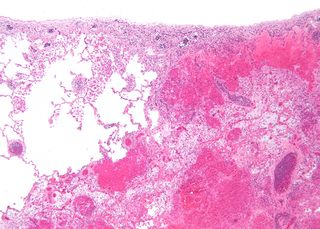Related Research Articles

The Milwaukee Brewers are an American professional baseball team based in Milwaukee. They compete in Major League Baseball (MLB) as a member club of the National League (NL) Central division. The Brewers are named for the city's association with the brewing industry. Since 2001, they have played their home games at American Family Field, which has a seating capacity of 41,900.
Vascular dementia (VaD) is dementia caused by problems in the supply of blood to the brain, typically a series of minor strokes, leading to worsening cognitive abilities, the decline occurring step by step. The term refers to a syndrome consisting of a complex interaction of cerebrovascular disease and risk factors that lead to changes in brain structures due to strokes and lesions, resulting in changes in cognition. The temporal relationship between a stroke and cognitive deficits is needed to make the diagnosis.

Infarction is tissue death (necrosis) due to inadequate blood supply to the affected area. It may be caused by artery blockages, rupture, mechanical compression, or vasoconstriction. The resulting lesion is referred to as an infarct (from the Latin infarctus, "stuffed into").
In neurology, abulia, or aboulia, refers to a lack of will or initiative and can be seen as a disorder of diminished motivation (DDM). Abulia falls in the middle of the spectrum of diminished motivation, with apathy being less extreme and akinetic mutism being more extreme than abulia. The condition was originally considered to be a disorder of the will, and aboulic individuals are unable to act or make decisions independently; and their condition may range in severity from subtle to overwhelming.

CADASIL or CADASIL syndrome, involving cerebral autosomal dominant arteriopathy with subcortical infarcts and leukoencephalopathy, is the most common form of hereditary stroke disorder, and is thought to be caused by mutations of the Notch 3 gene on chromosome 19. The disease belongs to a family of disorders called the leukodystrophies. The most common clinical manifestations are migraine headaches and transient ischemic attacks or strokes, which usually occur between 40 and 50 years of age, although MRI is able to detect signs of the disease years prior to clinical manifestation of disease.

In neuroanatomy, the corona radiata is a white matter sheet that continues inferiorly as the internal capsule and superiorly as the centrum semiovale. This sheet of both ascending and descending axons carries most of the neural traffic from and to the cerebral cortex. The corona radiata is associated with the corticopontine tract, the corticobulbar tract, and the corticospinal tract.

A cerebral infarction is the pathologic process that results in an area of necrotic tissue in the brain. It is caused by disrupted blood supply (ischemia) and restricted oxygen supply (hypoxia), most commonly due to thromboembolism, and manifests clinically as ischemic stroke. In response to ischemia, the brain degenerates by the process of liquefactive necrosis.

A watershed stroke is defined as a brain ischemia that is localized to the vulnerable border zones between the tissues supplied by the anterior, posterior and middle cerebral arteries. The actual blood stream blockage/restriction site can be located far away from the infarcts. Watershed locations are those border-zone regions in the brain supplied by the major cerebral arteries where blood supply is decreased. Watershed strokes are a concern because they comprise approximately 10% of all ischemic stroke cases. The watershed zones themselves are particularly susceptible to infarction from global ischemia as the distal nature of the vasculature predisposes these areas to be most sensitive to profound hypoperfusion.
Anemic infarcts are white or pale infarcts caused by arterial occlusions, and are usually seen in the heart, kidney and spleen. These are referred to as "white" because of the lack of hemorrhaging and limited red blood cells accumulation,. The tissues most likely to be affected are solid organs which limit the amount of hemorrhage that can seep into the area of ischemic necrosis from adjoining capillary beds. The organs typically include single blood supply. The infarct generally results grossly in a wedge shaped area of necrosis with the apex closest to the occlusion and the base at the periphery of the organ. The margins will become better defined with time with a narrow rim of congestion attributable to inflammation at the edge of the lesion. Relatively few extravasated red cells are lysed so the resulting hemosiderosis is limited and results in a progressively more pale area of infarction with time. Ischemic coagulative necrosis results and fibrosis of the affected area develops from the reparative response beginning at the preserved margins and working its way inwards. One exception to coagulative necrosis is the brain, which undergoes liquefactive necrosis in response to infarction.

Hemorrhagic infarcts are infarcts commonly caused by occlusion of veins, with red blood cells entering the area of the infarct, or an artery occlusion of an organ with collaterals or dual circulation. This is commonly seen in brain, lungs, and the GI tract, areas referred to as having "loose tissue," or dual circulation. Loose-textured tissue allows red blood cells released from damaged vessels to diffuse through the necrotic tissue. White infarcts can become hemorrhagic with reperfusion. Compare to Anemic infarct. Hemorrhagic infarction is also associated with testicular torsion.

Lacunar stroke or lacunar cerebral infarct (LACI) is the most common type of ischemic stroke, resulting from the occlusion of small penetrating arteries that provide blood to the brain's deep structures. Patients who present with symptoms of a lacunar stroke, but who have not yet had diagnostic imaging performed, may be described as suffering from lacunar stroke syndrome (LACS).
The lenticulostriate arteries, anterolateral central arteries, or antero-lateral ganglionic branches are a group of small arteries arising from the initial part M1 of the middle cerebral artery that supply the basal ganglia.

Total anterior circulation infarct (TACI) is a type of cerebral infarction affecting the entire anterior circulation supplying one side of the brain.

Partial anterior circulation infarct (PACI) is a type of cerebral infarction affecting part of the anterior circulation supplying one side of the brain.

Posterior circulation infarct (POCI) is a type of cerebral infarction affecting the posterior circulation supplying one side of the brain.
The International Studies of Infarct Survival (ISIS) were four randomized controlled trials of several drugs for treating suspected acute myocardial infarction. More than 134,000 patients from over 20 countries took part in four large simple trials between 1981 and 1993, coordinated from Oxford, England.

Charles Miller Fisher was a Canadian neurologist whose notable contributions include the first detailed descriptions of lacunar strokes, the identification of transient ischemic attacks as stroke precursors, the identification of the link between carotid atherosclerosis and stroke, and the description of a variant form of Guillain–Barré syndrome which bears his name.
George Emerson Brewer was an American surgeon and urologist known for his contributions to the eponymous Brewer infarcts.
A Zahn infarct is a pseudo-infarction of the liver, consisting of an area of congestion with parenchymal atrophy but no necrosis, and usually due to obstruction of a branch of the portal vein. Zahn infarcts are unique in that there is collateral congestion of liver sinusoids that do not include areas of anoxia seen in most infarcts. Fibrotic tissue may develop in the area of the infarct and it could be caused by an occlusive phlebitis in portal vein radicles. Non ischemic infarct of liver with lines of Zahn.

A placental infarction results from the interruption of blood supply to a part of the placenta, causing its cells to die.